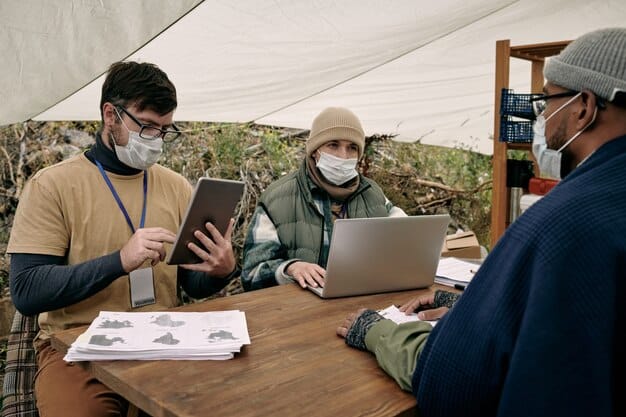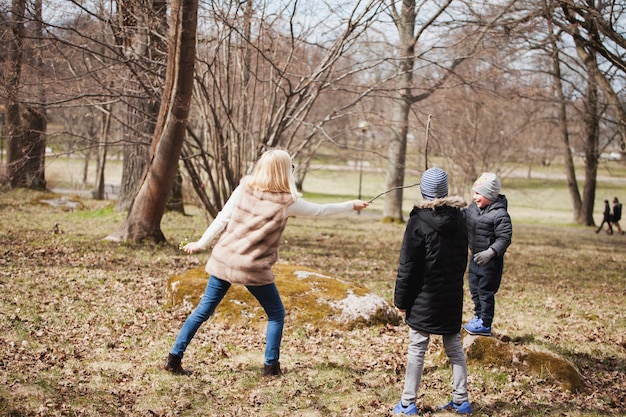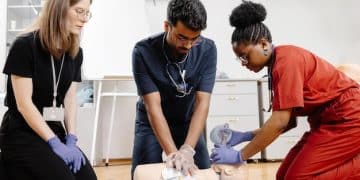Community Emergency Preparedness Plan: A Neighborhood Guide

Creating a community emergency preparedness plan is essential for safeguarding your neighborhood by identifying potential risks, establishing communication strategies, and organizing resources to ensure a coordinated response during crises.
Is your neighborhood ready for the unexpected? Creating a community emergency preparedness plan: protecting your neighborhood can be a proactive and empowering way to ensure the safety and well-being of everyone around you. Let’s explore how to build a robust plan tailored to your community’s needs.
Why Creating a Community Emergency Preparedness Plan Matters
Taking the initiative to develop a community emergency preparedness plan is crucial for several reasons. It helps to reduce the impact of disasters, promotes self-sufficiency, and fosters a stronger sense of community. When emergencies strike, a well-coordinated response can save lives and minimize damage.
Preparedness isn’t just about individual actions but about collective resilience. By working together, neighbors can pool resources, share knowledge, and support each other during times of crisis. This collective approach not only improves response times but also enhances community bonds.
Assessing Local Risks and Vulnerabilities
The first step in creating a community emergency preparedness plan involves identifying the unique risks and vulnerabilities specific to your neighborhood. This assessment should include natural disasters, such as earthquakes, floods, and wildfires, as well as man-made emergencies like power outages and hazardous material spills.
Building a Resilient Community
A resilient community is one that can withstand and recover quickly from adversity. This involves not only physical preparedness but also mental and emotional readiness. By fostering a culture of preparedness, communities can build the capacity to bounce back from even the most challenging situations.
- Identify potential hazards specific to your area.
- Assess the vulnerability of different populations within the community, such as the elderly or those with disabilities.
- Evaluate the availability of local resources, including emergency shelters, medical facilities, and communication networks.
In conclusion, creating a community emergency preparedness plan is a proactive measure that enhances safety and resilience. By identifying local risks and promoting collective action, neighbors can create a strong, supportive network ready to face any challenge.

Forming a Neighborhood Preparedness Team
A dedicated neighborhood preparedness team is essential for coordinating efforts and ensuring that the plan is effectively implemented. This team should consist of representatives from various parts of the community, including homeowners, renters, and local leaders. Each member should have specific roles and responsibilities to ensure accountability and efficiency.
The team’s primary responsibilities include developing and maintaining the emergency preparedness plan, organizing training exercises, and coordinating communication among residents. Regular meetings and ongoing communication are crucial for keeping the plan current and relevant.
Defining Roles and Responsibilities
Clearly defined roles and responsibilities are critical for effective teamwork. Some key roles to consider include a team leader, communication coordinator, resource manager, and medical liaison. Each role should have specific tasks and responsibilities outlined in the plan.
Recruiting and Training Volunteers
Volunteers are the backbone of any community preparedness effort. Recruiting and training volunteers can significantly enhance the team’s capacity to respond effectively during emergencies. Training should cover basic first aid, CPR, communication protocols, and evacuation procedures.
- Establish clear lines of communication and decision-making.
- Conduct regular meetings to review and update the plan.
- Provide training and resources to equip team members with the necessary skills and knowledge.
In summary, forming a neighborhood preparedness team is a crucial step in creating a resilient community. By defining roles, recruiting volunteers, and providing training, the team can effectively coordinate efforts and ensure the safety of all residents during emergencies.
Establishing Communication Networks
Effective communication is paramount during emergencies. Having reliable channels to disseminate information, coordinate resources, and provide support can make a significant difference in the outcome. This involves establishing both primary and backup communication methods to ensure connectivity even when traditional systems fail.
Communication isn’t just about technology but also about building relationships and trust within the community. By fostering open communication channels, residents can share information, offer assistance, and support each other during times of crisis.
Utilizing Technology and Social Media
Technology and social media can be powerful tools for disseminating information quickly and efficiently. This includes using email lists, text messaging services, and social media platforms to share alerts, updates, and resources.
Creating a Neighborhood Emergency Contact List
A neighborhood emergency contact list is essential for facilitating communication and providing support during emergencies. This list should include contact information for all residents, as well as any special needs or skills they may possess.
- Establish a communication tree to disseminate information quickly.
- Utilize local radio stations or community bulletin boards to share updates.
- Encourage residents to sign up for emergency alerts and notifications.
In conclusion, establishing reliable communication networks is critical for effective emergency preparedness. By utilizing technology, creating contact lists, and fostering open communication channels, communities can stay informed and connected during times of crisis.

Stockpiling Essential Supplies and Resources
Having access to essential supplies and resources is crucial for self-sufficiency during emergencies. This involves stockpiling food, water, medical supplies, and other critical items to ensure that residents can meet their basic needs until help arrives. The amount of supplies needed will vary depending on the size of the community and the potential duration of the emergency.
Stockpiling isn’t just about accumulating supplies but also about organizing and maintaining them. This involves storing items in a safe, accessible location, rotating stock to prevent spoilage, and ensuring that residents know where to find them.
Creating Emergency Kits for Each Household
Encourage each household to create its own emergency kit containing essential supplies such as food, water, first aid supplies, and a flashlight. These kits should be customized to meet the specific needs of each family, including any medical conditions or dietary restrictions.
Establishing a Community Resource Center
A community resource center can serve as a central location for storing and distributing essential supplies during emergencies. This center should be equipped with backup generators, communication equipment, and other resources to support the community’s needs.
- Compile a list of essential supplies and estimate the amount needed for the community.
- Organize a supply drive to collect donations from residents and local businesses.
- Establish protocols for distributing supplies equitably and efficiently.
In summary, stockpiling essential supplies and resources is a vital component of community emergency preparedness. By creating emergency kits, establishing resource centers, and organizing supply drives, neighborhoods can ensure that residents have access to the items they need to survive and thrive during emergencies.
Developing Evacuation Plans and Procedures
In some emergencies, evacuation may be necessary to protect residents from harm. Developing clear and well-rehearsed evacuation plans and procedures is essential for ensuring that everyone can safely leave the area. These plans should include designated evacuation routes, assembly points, and transportation options.
Evacuation isn’t just about physical movement but also about communication and coordination. This involves alerting residents to the need to evacuate, providing clear instructions, and ensuring that everyone can reach safety.
Identifying Safe Evacuation Routes
Work with local authorities to identify safe evacuation routes that avoid potential hazards such as flood zones or areas prone to landslides. These routes should be clearly marked and easily accessible to all residents.
Establishing Assembly Points
Designate assembly points where residents can gather after evacuating their homes. These points should be located in safe, accessible areas and equipped with basic supplies such as water and first aid kits.
- Conduct evacuation drills to familiarize residents with the routes and procedures.
- Provide transportation assistance to those who may need it, such as the elderly or those with disabilities.
- Communicate regularly with local authorities to stay informed about potential evacuation orders.
In conclusion, developing effective evacuation plans and procedures is critical for protecting residents during emergencies. By identifying safe routes, establishing assembly points, and conducting drills, communities can ensure that everyone can evacuate safely and efficiently.
Conducting Drills and Training Exercises
Regular drills and training exercises are essential for reinforcing preparedness skills and identifying areas for improvement. These exercises should simulate real-life emergency scenarios and involve the entire community. By practicing these skills, residents can build confidence and resilience.
Drills and exercises aren’t just about physical skills but also about mental and emotional readiness. This involves practicing decision-making under pressure, communicating effectively, and supporting each other during times of stress.
Simulating Emergency Scenarios
Design realistic emergency scenarios that reflect the unique risks and vulnerabilities of the community. These scenarios should include elements such as power outages, hazardous material spills, and natural disasters.
Providing Hands-On Training
Offer hands-on training in basic skills such as first aid, CPR, and fire safety. These skills can be invaluable during emergencies and empower residents to take action when needed.
- Involve local emergency responders in the drills and exercises.
- Evaluate the effectiveness of the plan and identify areas for improvement.
- Celebrate successes and acknowledge the contributions of participants.
In summary, conducting regular drills and training exercises is critical for building community resilience. By simulating emergency scenarios, providing hands-on training, and evaluating performance, neighborhoods can enhance their preparedness and ensure that residents are ready to respond effectively during crises.
Maintaining and Updating the Plan Regularly
A community emergency preparedness plan is not a one-time project but an ongoing commitment. Regular maintenance and updates are essential to ensure that the plan remains relevant and effective. This involves reviewing the plan annually, updating contact information, refreshing supplies, and incorporating lessons learned from past events.
Maintenance and updates aren’t just about paperwork and logistics but also about community engagement. This involves involving residents in the review process, soliciting feedback, and incorporating new ideas and perspectives.
Establishing a Review Schedule
Create a schedule for reviewing and updating the plan at least once a year. This ensures that the plan remains current and reflects any changes in the community’s needs or risk profile.
Soliciting Feedback from Residents
Encourage residents to provide feedback on the plan and suggest improvements. This can be done through surveys, community meetings, or online forums.
- Update the plan based on feedback, lessons learned, and changes in the community.
- Communicate any updates to residents and ensure that everyone is aware of the changes.
- Celebrate the community’s commitment to preparedness and encourage ongoing participation.
In conclusion, maintaining and updating the community emergency preparedness plan is essential for ensuring its long-term effectiveness. By establishing a review schedule, soliciting feedback, and incorporating updates, neighborhoods can build a resilient and prepared community.
| Key Point | Brief Description |
|---|---|
| ⚠️ Risk Assessment | Identify potential local hazards and community vulnerabilities. |
| 🤝 Team Formation | Establish a team to coordinate preparedness efforts. |
| 📢 Communication | Create reliable communication networks within the community. |
| 📦 Supplies | Stockpile essential supplies and resources for self-sufficiency. |
Frequently Asked Questions
▼
Start by assessing local risks, forming a preparedness team, and establishing communication networks. These initial steps provide a foundation for a comprehensive plan.
▼
It is recommended to review and update your plan at least once a year to ensure it remains current and effective based on changing community needs.
▼
Include food, water, first aid supplies, flashlights, batteries, and any necessary medications to sustain individuals in your household for at least 72 hours.
▼
Use email lists, text message services, and social media platforms to quickly disseminate information, updates, and resources during emergencies for effective response.
▼
Drills and exercises reinforce preparedness skills, identify areas for improvement, and build community confidence in responding effectively to emergency situations.
Conclusion
Creating a community emergency preparedness plan: protecting your neighborhood isn’t just about individual readiness; it’s about building a resilient, interconnected community that’s ready to face any challenge together. By taking proactive steps to assess risks, form teams, establish communication networks, stockpile supplies, and conduct drills, neighborhoods can significantly enhance their ability to respond effectively and protect the well-being of all residents.





